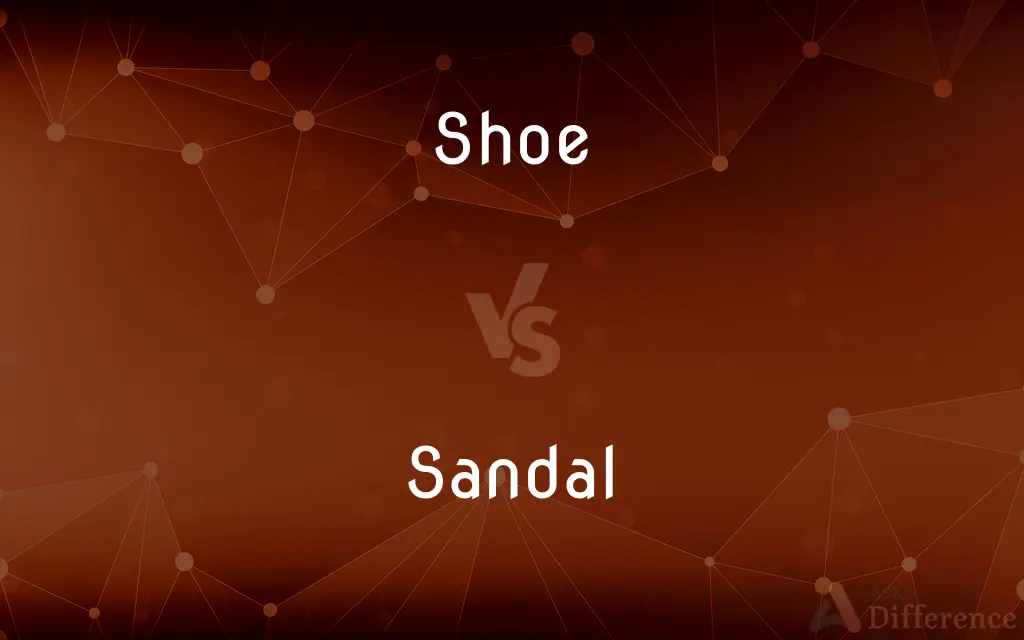Shoe vs. Sandal — What's the Difference?
By Urooj Arif & Maham Liaqat — Updated on March 18, 2024
Shoes enclose the entire foot, offering more protection, while sandals are open footwear with straps, providing breathability and ease of wear.

Difference Between Shoe and Sandal
Table of Contents
ADVERTISEMENT
Key Differences
Shoes are designed to cover the entire foot, providing protection, support, and warmth. Sandals, in contrast, have an open structure with straps that secure the sole to the foot, offering more breathability and comfort in warmer climates.
The primary purpose of shoes is to protect the feet from environmental hazards and to provide a certain level of insulation. Sandals are primarily worn for comfort in warm weather, allowing air to circulate around the feet.
Shoes come in various styles, including casual, formal, athletic, and specialty types for specific activities or conditions. Sandals are generally more casual, though there are dressier options for formal occasions.
Material-wise, shoes can be made from leather, synthetic materials, rubber, and textiles. Sandals are often made from lighter materials like leather, rubber, and synthetic fabrics, focusing on comfort and airiness.
While shoes are suitable for a wide range of activities and environments, from sports to formal events, sandals are preferred in casual settings, beaches, and during hot weather. However, some sandals are designed for hiking and outdoor activities, offering more foot freedom while still providing support.
ADVERTISEMENT
Comparison Chart
Coverage
Encloses the entire foot
Open design with straps
Purpose
Protection, support, warmth
Comfort, breathability
Styles
Casual, formal, athletic, specialty
Mostly casual, some formal options
Materials
Leather, synthetic, rubber, textiles
Leather, rubber, synthetic fabrics
Suitable For
Wide range of activities and environments
Casual settings, hot weather, some outdoor activities
Compare with Definitions
Shoe
Footwear that covers the entire foot.
He bought a new pair of shoes for his job interview.
Sandal
Some designed for specific activities.
Hiking sandals are designed with added support for rough terrain.
Shoe
Designed for protection and support.
Running shoes are essential for providing the right support during exercise.
Sandal
Focuses on comfort and breathability.
Sandals are perfect for keeping your feet cool during the summer.
Shoe
Can be specialized based on activity.
Climbing shoes have sticky rubber soles for better grip on rocks.
Sandal
Typically worn in casual settings.
For the backyard barbecue, he chose a pair of casual sandals.
Shoe
Made from various materials.
Leather shoes are popular for formal occasions due to their durability and classic look.
Sandal
Made from light materials.
The sandals were made from a lightweight synthetic material, ideal for hot weather.
Shoe
Suitable for diverse environments.
Waterproof shoes are ideal for hiking in wet conditions.
Sandal
Sandals are an open type of footwear, consisting of a sole held to the wearer's foot by straps going over the instep and around the ankle. Sandals can also have a heel.
Shoe
A shoe is an item of footwear intended to protect and comfort the human foot. Shoes are also used as an item of decoration and fashion.
Sandal
A shoe consisting of a sole fastened to the foot by thongs or straps.
Shoe
A durable covering for the human foot, made of leather or similar material with a rigid sole and heel, usually extending no higher than the ankle.
Sandal
A low-cut shoe fastened to the foot by an ankle strap.
Shoe
A horseshoe.
Sandal
A rubber overshoe cut very low and covering little more than the sole of the shoe.
Shoe
A strip of metal fitted onto the bottom of a sled runner.
Sandal
A strap or band for fastening a low shoe or slipper on the foot.
Shoe
The base for the supports of the superstructure of a bridge.
Sandal
Sandalwood.
Shoe
The ferrule on the end of a cane.
Sandal
A type of open shoe made up of straps or bands holding a sole to the foot
Shoe
The casing of a pneumatic tire.
Sandal
Sandalwood
Shoe
A device that retards or stops the motion of an object, as the part of a brake that presses against the wheel or drum.
Sandal
A long narrow boat used on the Barbary coast.
Shoe
The sliding contact plate on an electric train or streetcar that conducts electricity from the third rail.
Sandal
Same as Sendal.
Sails of silk and ropes of sandal.
Shoe
A chute, as for conveying grain from a hopper.
Sandal
Sandalwood.
Shoe
(Games) A case from which playing cards are dealt one at a time.
Sandal
A kind of shoe consisting of a sole strapped to the foot; a protection for the foot, covering its lower surface, but not its upper.
Shoe
Position; status
You would understand my decision if you put yourself in my shoes.
Sandal
A shoe consisting of a sole fastened by straps to the foot
Shoe
Plight
I wouldn't want to be in her shoes.
Sandal
Open footwear secured by straps.
She wore comfortable sandals on her walk along the beach.
Shoe
To furnish or fit with a shoe or shoes.
Shoe
To cover with a wooden or metal guard to protect against wear.
Shoe
A protective covering for the foot, with a bottom part composed of thick leather or plastic sole and often a thicker heel, and a softer upper part made of leather or synthetic material. Shoes generally do not extend above the ankle, as opposed to boots, which do.
Get your shoes on now, or you'll be late for school.
Shoe
A piece of metal designed to be attached to a horse's foot as a means of protection; a horseshoe.
Throw the shoe from behind the line, and try to get it to land circling (a ringer) or touching the far stake.
Shoe
(card games) A device for holding multiple decks of playing cards, allowing more games to be played by reducing the time between shuffles.
Shoe
Something resembling a shoe in form, position, or function, such as a brake shoe.
Remember to turn the rotors when replacing the brake shoes, or they will wear out unevenly.
Shoe
A band of iron or steel, or a ship of wood, fastened to the bottom of the runner of a sleigh, or any vehicle which slides on the snow.
Shoe
A drag, or sliding piece of wood or iron, placed under the wheel of a loaded vehicle, to retard its motion in going down a hill.
Shoe
The part of a railroad car brake which presses upon the wheel to retard its motion.
Shoe
(architecture) A trough-shaped or spout-shaped member, put at the bottom of the water leader coming from the eaves gutter, so as to throw the water off from the building.
Shoe
A trough or spout for conveying grain from the hopper to the eye of the millstone.
Shoe
An inclined trough in an ore-crushing mill.
Shoe
An iron socket or plate to take the thrust of a strut or rafter.
Shoe
An iron socket to protect the point of a wooden pile.
Shoe
(engineering) A plate, or notched piece, interposed between a moving part and the stationary part on which it bears, to take the wear and afford means of adjustment; called also slipper and gib.
Shoe
Part of a current collector on electric trains which provides contact either with a live rail or an overhead wire (fitted to a pantograph in the latter case).
Shoe
(historical) An ingot of gold or silver shaped somewhat like a traditional Chinese shoe, formerly used in trade in the Far East.
Shoe
The outer cover or tread of a pneumatic tire, especially for an automobile.
Shoe
A pneumatic tire, especially for an automobile.
Shoe
To put shoes on one's feet.
Men and women clothed and shod for the ascent.
Shoe
To put horseshoes on a horse.
Shoe
To equip an object with a protection against wear.
The billiard cue stick was shod in silver.
Shoe
A covering for the human foot, usually made of leather, having a thick and somewhat stiff sole and a lighter top. It differs from a boot on not extending so far up the leg.
Your hose should be ungartered, . . . yourshoe untied.
Spare none but such as go in clouted shoon.
Shoe
Anything resembling a shoe in form, position, or use.
Shoe
The outer cover or tread of a pneumatic tire, esp. for an automobile.
Shoe
To furnish with a shoe or shoes; to put a shoe or shoes on; as, to shoe a horse, a sled, an anchor.
Shoe
To protect or ornament with something which serves the purpose of a shoe; to tip.
The sharp and small end of the billiard stick, which is shod with brass or silver.
Shoe
Footwear shaped to fit the foot (below the ankle) with a flexible upper of leather or plastic and a sole and heel of heavier material
Shoe
(card games) a case from which playing cards are dealt one at a time
Shoe
U-shaped plate nailed to underside of horse's hoof
Shoe
A restraint provided when the brake linings are moved hydraulically against the brake drum to retard the wheel's rotation
Shoe
Furnish with shoes;
The children were well shoed
Common Curiosities
Are there any health benefits to wearing sandals over shoes?
Sandals allow for more air circulation around the feet, which can reduce the risk of fungal infections and keep feet cooler in hot temperatures.
Can sandals provide the same level of support as shoes?
While traditional sandals may not offer as much support as closed shoes, many modern sandals are designed with arch support and cushioning for comfort and stability.
Can sandals be worn for formal occasions?
While sandals are generally casual, there are dressier options available that can be appropriate for formal occasions.
Are shoes always closed?
Most shoes are designed to cover the entire foot, but there are styles with cutouts or open areas for stylistic or functional reasons.
How do I choose between shoes and sandals for an activity?
Consider the activity's nature, the environment, and weather conditions. Shoes offer more protection and support for activities involving rough terrain or cooler temperatures, while sandals are suitable for casual activities in warm weather.
Can wearing sandals be detrimental to foot health?
Wearing sandals with poor support for extended periods can lead to foot pain or issues like plantar fasciitis, especially during activities requiring more foot support or protection.
Can sandals be worn all year round?
In warmer climates, sandals can be worn throughout the year. In cooler climates, they are typically worn during warmer seasons.
Is it acceptable to wear sandals to work?
This depends on the workplace dress code. Some workplaces allow sandals, especially in casual settings, while others require closed-toe shoes for safety or formal reasons.
How do I care for sandals compared to shoes?
Sandals often require less maintenance due to their open structure and materials but should still be cleaned regularly. Shoes may need more specific care, especially leather and specialty footwear, to maintain their condition and functionality.
Are there environmentally friendly options for both shoes and sandals?
Yes, there are eco-friendly options made from sustainable materials and ethical manufacturing processes for both shoes and sandals.
Share Your Discovery

Previous Comparison
Heptane vs. Hexane
Next Comparison
Furan vs. OxoleAuthor Spotlight
Written by
Urooj ArifUrooj is a skilled content writer at Ask Difference, known for her exceptional ability to simplify complex topics into engaging and informative content. With a passion for research and a flair for clear, concise writing, she consistently delivers articles that resonate with our diverse audience.
Co-written by
Maham Liaqat













































